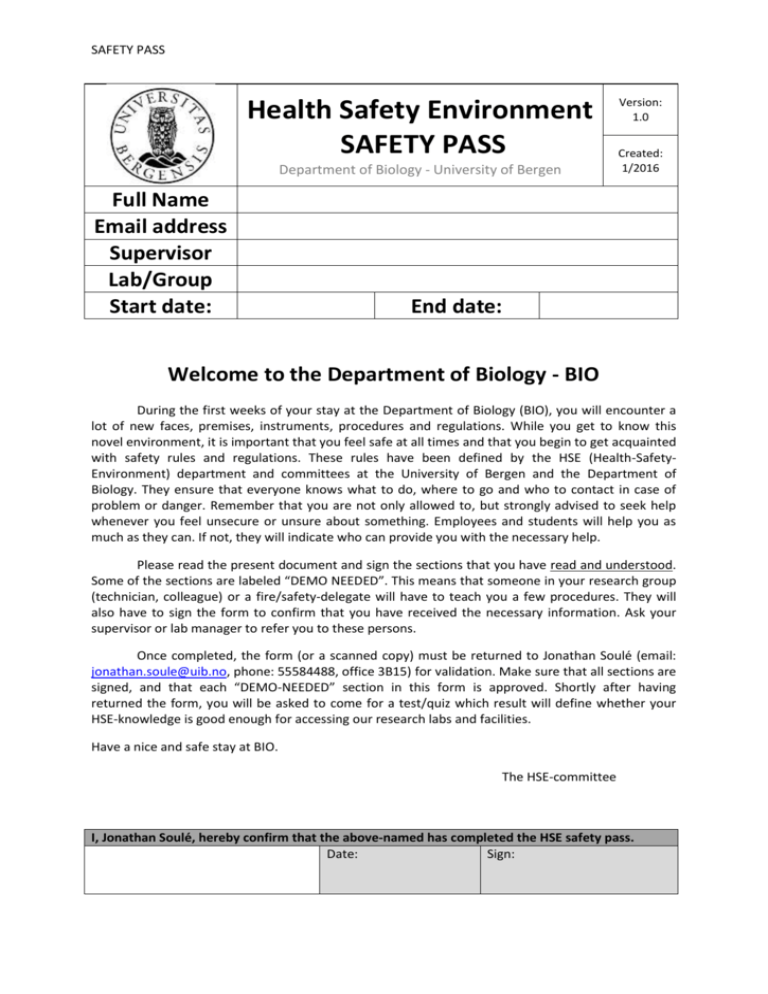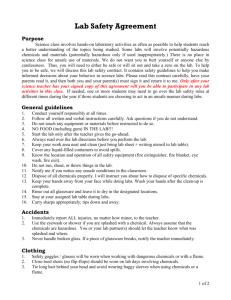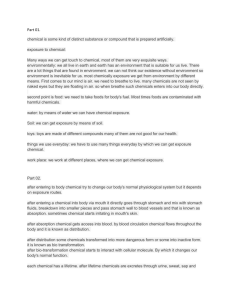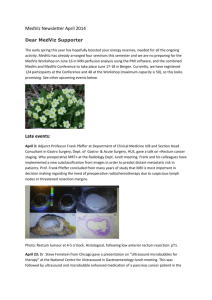safety pass
advertisement

SAFETY PASS Health Safety Environment SAFETY PASS Department of Biology - University of Bergen Full Name Email address Supervisor Lab/Group Start date: Version: 1.0 Created: 1/2016 End date: Welcome to the Department of Biology - BIO During the first weeks of your stay at the Department of Biology (BIO), you will encounter a lot of new faces, premises, instruments, procedures and regulations. While you get to know this novel environment, it is important that you feel safe at all times and that you begin to get acquainted with safety rules and regulations. These rules have been defined by the HSE (Health-SafetyEnvironment) department and committees at the University of Bergen and the Department of Biology. They ensure that everyone knows what to do, where to go and who to contact in case of problem or danger. Remember that you are not only allowed to, but strongly advised to seek help whenever you feel unsecure or unsure about something. Employees and students will help you as much as they can. If not, they will indicate who can provide you with the necessary help. Please read the present document and sign the sections that you have read and understood. Some of the sections are labeled “DEMO NEEDED”. This means that someone in your research group (technician, colleague) or a fire/safety-delegate will have to teach you a few procedures. They will also have to sign the form to confirm that you have received the necessary information. Ask your supervisor or lab manager to refer you to these persons. Once completed, the form (or a scanned copy) must be returned to Jonathan Soulé (email: jonathan.soule@uib.no, phone: 55584488, office 3B15) for validation. Make sure that all sections are signed, and that each “DEMO-NEEDED” section in this form is approved. Shortly after having returned the form, you will be asked to come for a test/quiz which result will define whether your HSE-knowledge is good enough for accessing our research labs and facilities. Have a nice and safe stay at BIO. The HSE-committee I, Jonathan Soulé, hereby confirm that the above-named has completed the HSE safety pass. Date: Sign: SAFETY PASS Section 1. SAFETY EQUIPMENT DEMO NEEDED Whenever your work involves manipulation of chemicals, solutions, samples of known or unknown origin, it is advised to evaluate the risks in advance. Check for pictograms (see section 3); look at the safety datasheet (MSDS) for info regarding hazards and how to protect yourself. What may you use to protect yourself or your samples? Gloves: gloves will help protecting your hands and skin against various types of chemical hazard. Depending on their specifications, they may protect again corrosive agents, staining solutions, acidic and alkaline solutions which may induce burns, and exposure to carcinogenic compounds. They will also protect your samples from contamination. Goggles: safety goggles protect your eyes and parts of your face against projections of liquids which properties might compromise your vision and damage your skin. They must be used when manipulating organic solvents, acidic/alkaline solutions, hot solutions, detergents and in situations where splashes and projections of particles are likely to occur. Masks: masks are necessary to protect your respiratory system against dust and particles, but will not help against gas and fumes. They are particularly useful when manipulating volatile powder. When work with animals (rats, mice), they are crucial to reducing the occurrence of allergic reactions. Note that several filter types exists; not all of them are equally efficient in all situations. Make sure that the filter type that you use is suitable with regards to the procedure that you are about to perform. Hood/Ventilated cabinets: Hood/ventilated cabinets allow you to manipulate hazardous chemicals (liquid, fumes, powder) in a much safer way. It is recommended to use them as much as possible, when technically possible. A special type of hoods called LAF-benches is designed to protect the content of the cabinet (cell culture, sterile preparations) from outside contamination, but not all LAF-benches do protect the user simultaneously. Do not hesitate to ask for help when unsure about hoods and safety. Note that the best level of protection may be obtained by combining use of these different types of safety equipment. For example, it is recommended to manipulate concentrated acidic solutions under a ventilated hood, while using gloves (goggles might be unnecessary due to the protective effect of the window of the hood, masks are obsolete due to the ventilation in the hood). SAFETY PASS In case of exposure to hazardous chemicals: Learn to recognize and use the emergency showers and eyewash stations! At BIO, the emergency showers are combined with an eyewash station and may be found in corridors (2 showers per floor). Both are critical to your health and safety as they will help flushing spills of dangerous (corrosive, burning, carcinogenic) chemicals away from your body, head and eyes. Emergency showers may be found in corridors nearby the laboratories. The showers are to be used in case of spills or exposure to dangerous chemicals (acid, corrosive …). Pull the chain to open the flow of water. Remain under the shower for 5-20 minutes depending on the properties of the chemical and the degree of exposure. Eyewash stations are mounted on every emergency shower at BIO and may be also found on/nearby water taps. They are to be used when dangerous liquid projections have reached the eyes. Open the tap and push/pull the button to open the flow of water. Flush your eyes for 5-20 minutes depending on the properties of the chemical and the degree of exposure. Different types of eyewash stations are available at BIO. It is therefore crucial that you get to know how to use the stations located at the vicinity of your workplace. I hereby confirm that I have read and understood the content of this section. Date: Sign: I hereby confirm that the above-signed has received appropriate information on safety equipment. Name: Date: Sign: Lab/Group: SAFETY PASS Section 2. FIRE – EVACUATION AND EQUIPMENTS DEMO NEEDED Get to know the surroundings! During the first weeks at BIO, use a bit of your time to find out where safety equipment is located. If your workplace is distant from your office/reading room, check the surroundings of both places. Find extinguishers, blankets and hoses. Find the closest exit as well as a secondary exit in case access to the closest exit is made impossible (smoke, fire, structural damage). Fire hose Fire extinguishers Fire blankets In case of alarm: if you are at “Biologen” (Thormøhlensgate 53A/B), a message will be broadcasted in the corridors. This message may differ depending on the origin of the alarm. LISTEN TO THE MESSAGE, it tells you what to do. You may thus be advised to “leave the building” or to “wait for further instructions”. If you are in the BIO-building at HiB (Thormøhlensgate 55), a bell will ring. Proceed to evacuating the building immediately. In case of evacuation: - Keep calm and leave your workplace; don’t waste time trying to take your personal belongings with you unless there are close to you. Evacuate the building by using the nearest emergency exit. Meet at the fire assembly point (main entrance, next to the pyramid). In case of fire: - Keep calm, evaluate the situation and act fast. If the fire is manageable, use fire hose, blankets or extinguishers Trigger the fire alarm (red boxes) Close all doors and windows to contain fire and smoke Call 110 (Fire Department) and report: o Who is calling, What has happened, Where the fire is Evacuate the building and meet at assembly point. SAFETY PASS Evacuation procedures If your workplace is at “Biologen” (Thormøhlensgate 53AB), follow the evacuation procedure described below. The assembly point is located by the pyramid in front of the HIB-building. - Go to the ground floor by following the green “exit” signs. USE STAIRS - NEVER USE LIFTS. Once you have reached the ground floor, find the way to the nearest exit door and go to assembly point. NEVER turn back unless the exit path is blocked. NEVER go back into the building unless the fire safety officer has given a clear signal that the situation is resolved. SAFETY PASS If your workplace is at HiB – BioBuilding (Thormøhlensgate 55), follow the evacuation procedure described below. The assembly point is located by the pyramid in front of the building. I hereby confirm that I have read and understood the content of this section. Date: Sign: I hereby confirm that the above-signed has received appropriate information on fire issues. Name: Date: Sign: Lab/Group: SAFETY PASS Section 3. CHEMICALS DEMO NEEDED There are plenty of chemicals in a laboratory that are harmless. There are also plenty of chemicals which are highly dangerous for your health. These chemicals are labelled with a pictogram which defines what type of hazard one may encounter. Learn to recognize the following pictograms. Note that these pictograms replace a series of orange pictograms which may still be found on older products stored in the lab. The older pictograms are the following: It is crucial that you learn the meaning of these symbols as they tell you what the risks are, what to think of when working with the corresponding chemicals, which safety equipment to consider when manipulating them (gloves, safety goggles, ventilated hood, etc.). Additionally, you will find safety statements and codes which define more precisely the danger encountered when manipulating specific chemicals. They are the Hazard statements or H-statements (“H” followed by a number, which describe the nature of the risks of a substance or mixture) and Precautionary statements or Pstatements (“P” followed by a number, which indicate how hazards may be prevented or reduced). SAFETY PASS Check the following page for more info: http://www.uib.no/en/poa/hms-portalen/89816/chemicalsand-safety-labelling. In the following example, the hazardous substance is clearly labeled with pictograms, H- and P-statements (highlighted in red boxes). All chemicals are delivered with a safety datasheet, the MSDS, which describes in details the substance or mixture, the risks and dangers, the actions to take in case of exposure, fire, waste and disposal. One should always read these datasheets before starting a procedure which involves hazardous chemicals. The MSDS is available online via EcoOnline, a register which gives access to all datasheets of all chemicals stored or in use at your workplace. If it appears to be difficult to find the MSDS in English via EcoOnline or any other online source (manufacturer), contact your lab-manager or Solveig Thorkildsen (Solveig.Thorkildsen@uib.no) who is the contact person for EcoOnline at BIO. EcoExposure is a personal register where you can register a single exposure as well as repeated exposures to carcinogenic substances (marked with the H-statements H340, H350 and H350i). If you use, have used or plan to use such chemicals, you must be registered in EcoExposure. Contact Solveig Thorkildsen for further information and access to the database. I hereby confirm that I have read and understood the content of this section. Date: Sign: I hereby confirm that the above-signed has received appropriate information on chemicals. Name: Date: Sign: Lab/Group: SAFETY PASS Section 4. HAZARDOUS WASTE In this section, you learn that laboratory waste MUST be handled/treated with care. Hazardous materials and solutions must be disposed of using specific procedures; sharp items must be kept in a secured container. Several types of containers are available for disposing of dangerous products. Depending of the danger linked to handling of the waste, you will have to choose between: Small, yellow containers: these are used to confine small, sharp/pointed objects made of metal or glass (cannulas, scalpel, razor blades, broken glass, and glass objects of limited size, such as coverslips and slides). Large, yellow containers: these are made for biological waste, gels (agarose or acrylamide-gels), gloves and all kinds of waste from infusion/injection like syringes and paper, empty chemical boxes and flasks. These containers may also be used to dispose of glass (broken glass, Pasteur pipettes, empty bottles and glass vials that used to contains chemicals). All yellow boxes must be sealed and labeled appropriately. The content of the container must be indicated using the “forbrenning” sticker. This label shall also mention your name, department/group, phone number and date. Large, red containers: these are used for disposing of chemical waste such as corrosive acids and bases, heavy metals, organic solvents with and without halogen, etc. Solutions must be stored in flasks which may be placed in the red containers. A declaration form for hazardous waste must accompany the flasks/containers. Ask your lab manager or the contact persons listed below for information and guidelines. Contact persons regarding waste disposal at the Department of Biology are Solveig Thorkildsen for the A-building (Solveig.Thorkildsen@uib.no), Evy Foss Skjoldal for the B-building (Evy Foss Skjoldal) and Paul Løvik for the HIB-Building (Paul Løvik). Contact them if you have doubt or need information/help. I hereby confirm that I have read and understood the content of this section. Date: Sign: SAFETY PASS Section 5. SAFETY RULES FOR WORK IN THE LAB When working in the lab, safety and hygiene rules apply at all times. Please follow the guidelines: It is prohibited to eat or drink in the laboratory. Freezers and refrigerators in the laboratories must not be used for the storage of food items. The same applies to the use of laboratory equipment – for example, beakers – for food and drink, even if the equipment is new and has not been used for chemicals. Generally speaking, it is recommended to wear protective goggles at all time. However, goggles MUST be worn whenever handling concentrated acidic or alkaline solutions, and whenever there is a risk for splashes. The wearing of contact lenses should be avoided where possible. If it cannot be avoided, it is particularly important to wear protective goggles. In case of splashes in the eyes, hazardous solutions may be trapped under the lens, thus reducing dramatically the efficiency of the emergency eye shower and increasing chances for damages. Use laboratory coats made of cotton. Synthetic fiber materials can produce sparks from static electricity and, in the case of undesirable events, can lead to burns as synthetic fibers may melt directly on your skin. Wear shoes that are “sealed” over the toes to avoid injuries in the event of a spillage of chemicals. Protective gloves must be worn when using corrosive, toxic, irritating or allergenic compounds, as well as for chemicals that are hazardous on contact with skin. Laboratories must always be kept clean and tidy. Never taste chemicals or solutions even if you think you are sure that they are harmless. Never use your mouth for pipetting. Use a rubber balloon, burette, pipette pump, electric pipetting device or other equipment. Spillages on workbenches and floors must be wiped up immediately, irrespective of whether they are from chemicals or water. Use gloves and other appropriate safety items when cleaning up spills. Wash hands thoroughly after contact with chemicals. Wash your hands even if you have been wearing gloves. Use soap and water, not organic solvents. Working with certain kinds of chemicals requires exposure registration. Ask your lab manager for guidance and advice. If your work or project involves risk factors such as exposure to fur-bearing animals, hazardous biological factors, specific hazardous chemicals, ionizing radiations over an annual dose of 6 mSv, sustained exposure to noise, among others, it is strongly recommended to take contact with the University’s health services for a health check prior to starting work activities. See http://www.uib.no/en/poa/hms-portalen/90280/health-checks and contact Tordis Myrlid Sundnes (Tordis.Sundnes@uib.no) for more info. You may get an appointment by sending a request to post@hms.uib.no. There should never be any unlabeled chemicals in the laboratory. The original packaging must always be marked in accordance with the Labelling Regulations (labels can be printed out from the Chemical Inventory). I hereby confirm that I have read and understood the content of this section. Date: Sign: SAFETY PASS Section 6. ROOM DATASHEETS The room datasheet is placed next to the entrance door of each and every lab or facility at BIO. It contains most of the necessary information regarding what happens in the lab, the risks and dangers, the methods often employed there. It also mentions the names and contact details of the persons who are in charge of the room and/or who have responsibilities in terms of HSE or fire safety. Contact these persons whenever you need help or feel unsure about something. Here is an example: Room number Other rooms which can be accessed from this room Contact details of the lab/room manager Dangers and risks encountered when working in this room Safety equipment which is necessary to work in this room List of those who are allowed to work in this room Methods and procedure in use in this room HSE-representatives Fire safety officer HSE coordinator I hereby confirm that I have read and understood the content of this section. Date: Sign: SAFETY PASS Section 7. HSE HANDBOOK – FIRE HANDBOOK At the Department of Biology, the HSE-handbook is available online. Follow the link: http://biologi.uib.no/Personal/hms/hms-handbok/Innholdsfortegnelse.php Originally available in Norwegian only, this document has been recently translated in English and is now available by mean of the language button at the top right corner of the page or via the following link: http://biologi.uib.no/Personal/hms/hms-handbok/Innholdsfortegnelse.php?lang=E You may also find useful information and advice on the HSE-gateway: http://www.uib.no/en/poa/hms-portalen SAFETY PASS The fire handbook for BIO is found at http://biologi.uib.no/Personal/hms/brannbok/brannbok.php and it has also been translated in English and is accessible via the language button at the top or via the following link: http://biologi.uib.no/Personal/hms/brannbok/brannbok.php?lang=E You may also access the common pages for fire safety procedures at the University of Bergen at: http://www.uib.no/en/poa/hms-portalen/79867/fire-safety I hereby confirm that I have read and understood the content of this section. Date: Sign: SAFETY PASS Section 8. REPORT AN HSE-PROBLEM The University of Bergen has recently implemented an electronic tool which gives employees and students the possibility to report HSE non-conformities. What are HSE non-conformities? HSE non-conformities are all adverse events and/or matters that have resulted or may result in harm to people, the environment and property, such as: fires and explosions break-in, theft, robbery and unauthorized access to buildings and areas damage to property and structural conditions in buildings personal injuries harmful emissions to the environment incorrect handling of chemicals, gas, biological agents and sources of radiation third party violence and threats (third party means persons who are not UiB employees) breaches of the health and safety legislation, guidelines and routines. How do I report HSE non-conformities? Go to https://avvik.app.uib.no/skjema/. Log on using your UiB username and password. Open an issue (“ny melding”), describe the problem that you want to report and submit the form online. OPEN AN ISSUE LOG IN As a visitor, you might not get direct access to this system, possibly because you do not have a personal UiB account with sufficient credentials. If so, simply contact any student or employee with a valid UiB account and ask this person to open an issue on your behalf. Your HSE-case will be processed with the same degree of priority as if you had submitted it by yourself. I hereby confirm that I have read and understood the content of this section. Date: Sign:










